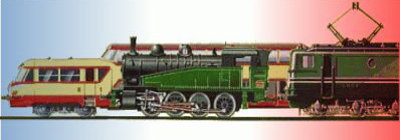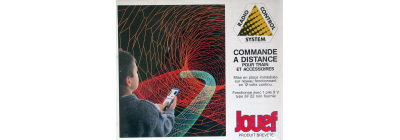
 - 6 volts power supply,
- 6 volts power supply,
- 12 volts power supply,
- Jouef-Matic system,
- Jouef Radio Control System,
- electric accessories,
- SNCF light signals,
During the half-century which has been just passed, Jouef manufactured various types of power supplies according to times. We will retain three types of power supplies whose characteristics are detailed..
The first batch of electric locomotives (electric locomotive BoBo 9003/9004 SNCF and the 0-4-0 tank-locomotive) appeared in 1955 and need a maximun 6 volts power supply in order to work. Thanks to the low consuption of the electric motor, locomotives can work under 4.5 volts which is the voltage of battery. The first power supply is a battery box which has the shape of a signal-box. It hides the 4.5 volts battery.
In 1958, a transformer and a sub-station transformer completed the power supplies range. Transformer existed with two main power
voltage 110 volts or 220 volts, the French main power supply network could deliver supply in one of those voltage depending on the place.
On the transformer and on the sub-station transformer, the central button can tune the output voltage and the current polarity.
For more details on this range of power supplies, see also : 6 volts power supplies.
In 1961, Jouef adopted new international standards and DC voltage current passed from 6 volts DC to 12 volts DC.
Note the transformer "Prima-Transfo" issued in 1963 and remaining unfollowed, the transformer
is set along a special rail track and the transformer weight provides electrical contacts and that we move a few
centimeters to reverse the polarity on tracks.
In parallel, the cell batteries boxes use three batteries flat 4.5 volts, instead of two batteries flat 4.5 volts,
new motor engines installed in locomotives being more compact but more greedy, and front lighting engine becoming general.
Transformers are fitted with a circuit breaker protecting the transformer in case of accidental short circuit or overload.
On technical side, operation of these processors is very simple, adjusting the voltage output being in the same way a rheostat
where one takes a more or less of turns secondary transformer.
The central button is used to adjust the output voltage as a potentiometer. A 3 positions button allows the stopping, walking forward or reverse.
Gradually, transformers are fitted with a 16 volts AC output to power the various electrical accessories (electric switching points, lamps,...).
The transformers will be marketed over many years, in two versions depending on the main voltage 110 volts or 220 volts until 1970,
then gradually twin-voltage or 220 volts from 1971 to 1978, and finally only 220 volts in the late 1970 when the EDF network releases
only the last tension. A circuit breaker protects against short-circuits or too strong calls for current.
In mid-1980, electronics became cheaper and cheaper, it made its appearance in switching power supplies, allowing smooth starts and stops even
in a low voltage delivered to the tracks. In mid 1990 a European directive for electrical appliances safety, has the effect of imposing
a block-low voltage transformer that plugs directly on the main plugs, voltage control to track and reverse polarity are made in a
second box with some electronics parts issuing a chopped voltage.
For more details on this range of power supplies, see also : 12 volts power supplies.

In late 1960, Jouef issued a remote control system, far ahead of its time in the world of model trains. It is a set of transmitters and receivers.
To each tramsitter channel, there is a receiver that is fitted in each corresponding locomotive. This allows an independent
control on the same track of several machines at different speeds and directions, and allow constant lighting even when stopped. If in the
first generation system, there are only eight receivers and two transmitters, each transmitter may alternatively order that
four receivers, and it will take time until 1976/1977 for the eight channels truly independent.
Until the beginning of the third millennium with the new digital power supply systems promises to be widely disseminated, which will
overpass limitation on the number of machines that can be ordered simultaneously.
For more details on this range of power supplies, see also dedicated page to Jouef-Matic system.

In 1989, Jouef issued a remote control system, which looked like television remote controls. This system is compatible with any network
running with 12 volts DC, and it can order a machine and up to four electrical accessories. It will be marketed until 1995/1996 under reference 9080.
For more details on this range of power supplies, see also dedicated page to Radio Control system.
In addition to the power supplies, Jouef has introduced a range of pulse and switch keyboards, and an electromagnetic relay
allows some automatic working.
For more details on this range of electric accessories, see also dedicated page to electric accessories,
To decorate networks, Jouef issued in 1967 a 3 light signals conformm to the SNCF signalling, followed shortly afterwards by a
portal signal with operating light signals. A complementary electronic block system provides more realism with trains stopping
at the red signal lights.
For more details on this range of SNCF light signals, see also dedicated page to light signals,
Page updated on November 09ᵗʰ 2016.